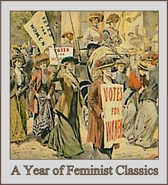 |
| Tahitian Women on the Beach (1891) via |
Published: 1901
It's about: This journal/memoir by painter Paul Gauguin chronicles time he spent in Tahiti living among the natives.
I thought: I love the post-impressionists, and I've always been intrigued by Paul Gauguin's paintings of Tahiti and the Tahitian people. I was hoping that his journal would tell me more about why Gauguin was so drawn to Tahitian culture and how it informed his unique style and approach to painting. It did, a little.
 |
| Two Tahitians (1899) via |
But Gauguin was an idealist, and you have to respect his vision and read his journal in that light if you are reading with the intent to understand him as an artist, as I was. He vividly describes bright colors of the island and the particular confidence and grace unique to the Tahitian women, which he tried to capture in his paintings. His detailed visual descriptions definitely are that of a painter (see the excerpt below.) I was especially fascinated with this. I also liked how Gauguin made an honest effort to engage with the culture - he even learned to speak the language fluently, and many of the original titles of his paintings are in Tahitian.
As a side note, I read the only available version of this book for the Kindle, but I wish I had ordered a print copy. First of all, the translation by O.F. Theis is the English translation in the public domain ... which means it's old, and not the best. The paintings included in the book were difficult to see on the Kindle. The biography of Gauguin included in the appendix had irritating and unnecessary bracketed comments from the editor as well as footnotes that referenced Wikipedia. I wasn't impressed with this edition, but hey, this is the kind of stuff you get once a work comes into the public domain.

Verdict: In between.
Reading Recommendations: If you like Gauguin's art, this journal gives a little more insight into his work, or at least how he hoped others would see it. Also, here's a recent NY Times article that claims Noa Noa was mostly made up or plagiarized, claiming that "The myth that absorbed [Gauguin] most fully was the myth in the making of Paul Gauguin." Interesting thoughts. Check it out.
Warnings: None.
Favorite excerpts:"She had the majestic sculptural form of her race, ample and at the same time gracious. The arms were like the two columns of a temple, simple, straight; and the whole bodily form with the long horizontal line of the shoulder, and the vast height terminating above in a point, inevitably made me think of the Triangle of the Trinity."
What I'm reading next: The House of Mirth by Edith Wharton







